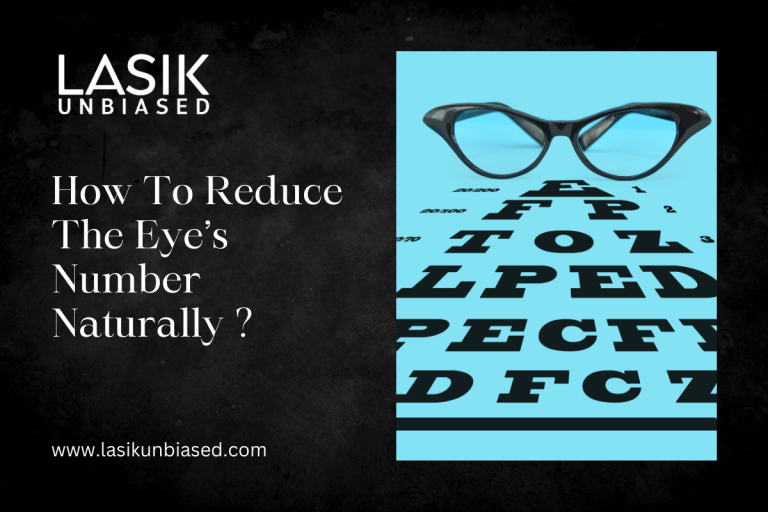A high eye number (also known as refractive errors such as myopia, hyperopia, or astigmatism) is a common concern for many people. Various factors, such as genetics, lifestyle choices, and environmental influences, can cause these conditions. While corrective lenses like glasses or contact lenses are often prescribed to help manage vision problems, many individuals are interested in exploring natural ways to reduce or manage their eye number.
Although significant changes in refractive error should always be discussed with an eye care professional, several natural practices may help maintain eye health and potentially improve vision over time. In this article, we will explore some methods believed to support eye health and potentially reduce eye number naturally.
1. Regular Eye Exercises
Eye exercises are a popular natural remedy for improving vision and reducing the need for corrective lenses. While no scientific evidence proves that eye exercises can significantly alter your eye number, they can help enhance eye muscle strength, reduce eye strain, and promote better focus.
Some exercises to consider include:
The 20-20-20 Rule
This simple exercise involves taking a break every 20 minutes using digital devices. Look at an object 20 feet away for at least 20 seconds to rest your eyes from the screen and reduce digital eye strain.
Palming
Relax and breathe deeply while visualizing soothing, calming scenes. This exercise can help reduce stress and eye fatigue.
Blinking Exercises
Blinking regularly can help reduce dry eye symptoms and refresh the tear film that lubricates the eyes. Practice blinking deliberately every few seconds to improve the flow of tears and support overall eye health.
2. Proper Nutrition for Eye Health
What you eat is crucial in maintaining eye health and reducing your eye number. Certain nutrients and vitamins can support your vision and prevent further deterioration.
Some essential nutrients to focus on for better eye health include:
Vitamin A
Vitamin A is essential for good vision, especially for night vision. Foods rich in vitamin A, such as carrots, sweet potatoes, and dark leafy greens, can help maintain eye health and may improve vision over time.
Omega-3 Fatty Acids
Omega-3 fatty acids are known for their anti-inflammatory properties and ability to support overall eye health. They can help prevent dry eyes, macular degeneration, and other vision-related problems. Foods like fish (salmon, sardines), flaxseeds, and walnuts are excellent sources of omega-3 fatty acids.
Lutein and Zeaxanthin
These antioxidants are found in foods like spinach, kale, and other green leafy vegetables. Lutein and zeaxanthin help protect the eyes from harmful light and support the retina’s health. They may also help prevent age-related vision problems.
Vitamin C and E
C and E are antioxidants that help protect the eyes from oxidative stress and free radical damage. Eating fruits and vegetables like oranges, strawberries, and almonds can help promote healthy vision.
3. Getting Sufficient Sleep
Sleep plays an essential role in the overall health of your eyes. When well-rested, your eyes get the time they need to repair and recharge. Inadequate sleep can lead to eye strain, dryness, and blurred vision.
Sleep deprivation can also increase the risk of developing conditions such as eye fatigue and dry eyes, contributing to an increased need for corrective lenses. Aim for 7-9 hours of restful sleep each night to allow your eyes to recover and function at their best.
4. Protecting Your Eyes from Harmful UV Rays
Exposure to harmful UV rays from the sun can lead to various eye problems, including cataracts, macular degeneration, and even vision deterioration. Protecting your eyes from UV rays can help maintain your vision and prevent worsening refractive errors.
Wear Sunglasses with UV Protection
Always wear sunglasses that offer 100% UVA and UVB protection outdoors. This helps shield your eyes from the damaging effects of the sun’s rays and reduces the risk of eye-related conditions that can contribute to worsening vision.
Use a Hat or Visor
In addition to sunglasses, wearing a wide-brimmed hat or visor can help reduce direct sunlight exposure to your eyes. This extra layer of protection can minimize the harmful effects of UV radiation.
5. Managing Screen Time
Excessive screen time is a major contributor to eye strain, leading to blurred vision, headaches, and dry eyes. Reducing the amount of time spent on digital devices and incorporating breaks can help alleviate these symptoms and prevent further deterioration of vision.
Follow the 20-20-20 Rule
As mentioned earlier, the 20-20-20 Rule is a great way to minimize the impact of prolonged screen time on your eyes. This simple practice can help reduce eye strain and support your eye health.
Maintain Proper Lighting
Ensure your workspace is well-lit and your digital devices are positioned at eye level. Avoid glare from screens, and adjust the brightness to a comfortable level to reduce eye strain. This will help reduce the pressure on your eyes and may prevent further vision deterioration.
6. Regular Eye Checkups
One of the most critical steps in maintaining eye health is to visit your eye doctor regularly for checkups and comprehensive eye exams. Early detection of refractive errors and other eye conditions can help prevent vision deterioration and improve your chances of maintaining good vision.
Corrective Lenses and Vision Therapy
If you have a refractive error, your optometrist or ophthalmologist may recommend corrective lenses (glasses or contact lenses). Sometimes, vision therapy may also be suggested to help retrain the eyes and improve visual clarity. Regular checkups ensure that your treatment plan is always up-to-date and effective.
7. Yoga and Relaxation Techniques
Stress can negatively affect your eyes and exacerbate vision problems, especially if you suffer from eye strain or dry eyes. Relax techniques like yoga, meditation, and deep breathing can reduce stress and promote better eye health. Specific yoga poses, such as “Child’s Pose” or “Forward Fold,” can help relax the eye muscles and improve blood circulation to the eyes.
8. Eye Protection and Avoiding Strain
Protecting your eyes from injury or Strain is essential for reducing the risk of further vision issues. When engaging in activities that could stress your eyes—such as reading, driving, or using a computer—ensure that you maintain proper posture and eye position. Take frequent breaks to rest your eyes and avoid putting them under unnecessary pressure.


